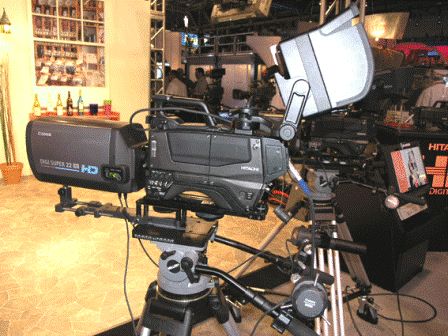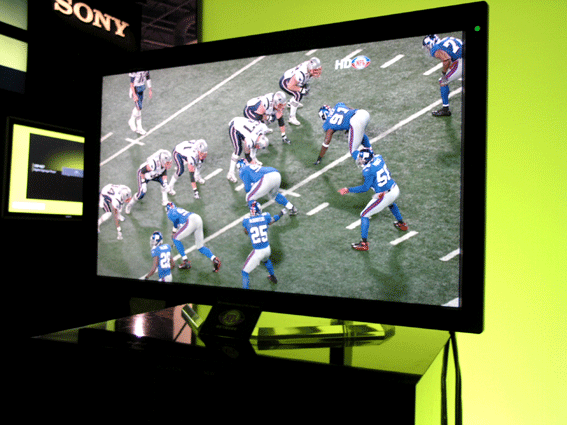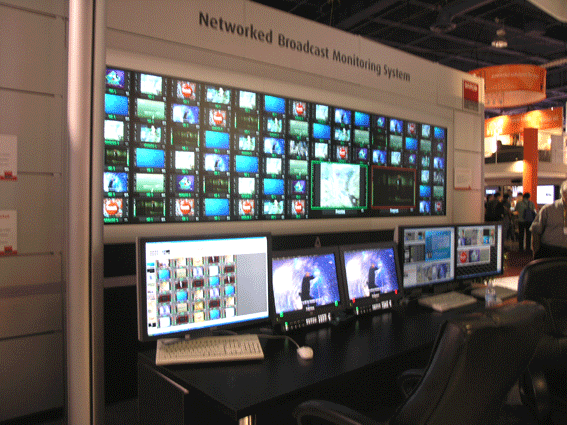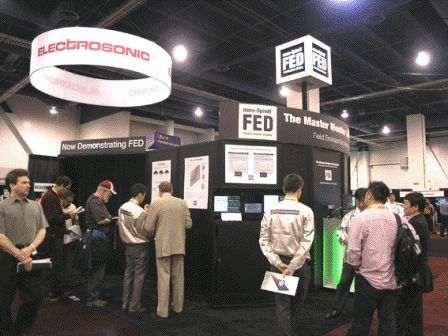NAB SHOW 2008 (Part 2) Trends in TV Cameras and Video Monitors
2008.5.12 UP
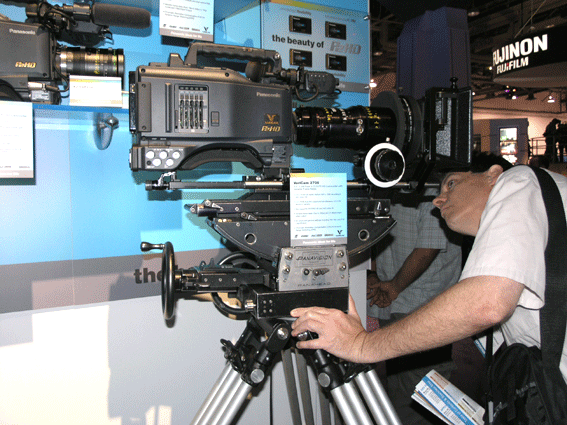
In the previous article in this series I talked about the general impressions gained at the NAB show and trends in tapeless camera technology. In this section I would like to discuss the technological trends for high definition, functionality and diversity of cameras and the video monitors and displays set to replace conventional CRT screens.
While compact, light-weight tapeless cameras received a lot of attention, there has also been great diversification and development in response to advances in digital cinema, such as high definition cameras, special high speed/high sensitivity cameras, special purpose ultra small cameras and so on. I would like to discuss a few of the technological developments that I caught my eye at the show.
Sony's new model digital cinema camera CINEALT F35 was on exhibition attracting lots of attention, however I would like to leave discussion of it for the digital cinema section in the next article in this series.
Panasonic exhibited their P2 HD compatible VARICAM. This camera is a 2.2 million pixel 2/3-inch IT-3CCD full HDTV, low smear, high sensitivity camera using AVC-Intra/H.264 coded compression with 1080/30P, 24P and compatibility via I/P switching. The camera exhibits rich gradation reproducibility using 14 bit DSP with wide dynamics. This camera is designed for drama, television commercial and movie production, and is due for release later in the year.
Ikegami TSUSHINKI displayed its flagship GFCAM Series as well as a new compact and light-weight high resolution full HDTV high-end camera, employing 2/3-inch 2.3 million pixel AIT CCDs, 14-bit A/D converters and independent video processing achieving a signal to noise ratio of 60dB. Also on display and receiving attention was the compact high resolution HDTV camera now fitted to the Kaguya lunar orbiter and operated by NHK.
Hitachi Kokusai Electric's exhibit focused on the new model SK-HD1000. This model features a dockable camera head and can be incorporated with coherent light wave transmission systems, wireless transmission systems, Triax systems and recorders to support a variety of uses. The camera employs 2/3-inch 2.3 million pixel IT-CCD for high resolution, and low noise electronics for greater sensitivity and higher signal to noise ratio. A light-weight design with a low center of gravity facilitates a higher degree of mobility and ease of operation.
JVC did not exhibit a camera at last year's Inter BEE, but at this year's NAB show they showed 3 models in their professional HDV camera Pro HD Series. These are not only light-weight, high maneuverability ENG camcorders, but also have movie camera capabilities.
I-Movix from Belgium exhibited their high-speed 'SprintCam.' The camera is assembled by the company using a Photron camera (mono-CMOS) and Fujinon lens. This ultra high speed camera takes between 250 to 8000 fps in 1080i features a 16 GB memory with real time recording and playback available. The camera allows up to 25 seconds of recording time at 1000 fps, and instant replay capabilities make it a great camera for sports and so on.
P+S TECHINIK from Germany also had an ultra high speed camera on display, that supports HDTV and shoots at 1-4000 fps (720P) or 1-2000 fps (1080P) using a CMOS for the sensor element, ASA sensitivity 1000, 16 GB memory and compatible with lenses such as Canon, Nikon and Panavision.
ICONIX from the U.S.A. showed its special purpose ultra small HD camera. The camera head only weighs 64 grams, and uses a 1/3-inch 3 CCD element, with full HD movie format, (1920/1080), 720, 480, 2K (2048/1080), with 60i/p, 24p, 14-bit A/D conversion, F8 sensitivity, high definition/high performance -a camera with diverse capabilities suitable for shooting in areas of poor accessibility, medical applications and movie production and the like.
Monitors that enable video quality assessment and management have long been sought after to replace the conventional CRT type and this years NAB featured a range of monitors and displays from various companies.
Sony, in addition to the LUMA LCD series, exhibited a range of new models from 42-inch (1920x1080), 24-inch (1920 x 1200), 20-inch (1680x1050), and 17-inch (1280x768) monitors. Whether the monitor is for coverage, editing or studio work, various sizes are available to suit differing spatial considerations. Also the TRIMASTER 42-inch monitor, with its accurate color reproduction, precision imaging and quality picture consistency was on display as a reference exhibit. This supports 4K (3840 x 2160) and full HD (1920 x 1080) with 10 bit drive, 120Hz double speed black frame insertion, with a high purity LED background and high precision signal processing engine. Also on exhibit was the 11-inch OLED Viewfinder (organic LED). This device does not need a backlight thanks to spontaneous lighting. This gives a much higher contrast ratio, excellent gradation and color reproduction free from fuzzy video in a thin, lightweight design and holds great future promise.
On display Panasonic had the large size 103-inch PDP mounted on the side of their booth, and a 17-inch (1280 x 768) LCD monitor featuring the newly developed IPS liquid crystal panel, quite stimulating when exhibited alongside other brands. The product features the 3-dimensional LUT (look up table) for the image processing engine, close to CRT color reproducibility via 10 bit processing, 120 Hz double-speed drive, black frame insert for lower afterimage, and a 176 degree wide viewing angle in four directions. Diagonal line compensation processing is applied to produce a natural looking video image by converting HD interlace signal to progressive signal with a delay time less than one field.
JVC exhibited their multi-format 24-inch (1920 x 1080), 20-inch (1680 x 945), 17-inch (1440 x 810) and 9-inch (800x450) LCD monitors, also displayed at Inter BEE. This is a high performance display with low frame delay, high-intensity, high contrast, wide angle viewing and independent processing for high fidelity and color reproducibility. They had a unique way of presenting these displays- several of them were arranged in a landscape style against the back of the booth, enabling visitors to evaluate their quality from up close. The enjoyable and diverse video content also attracted a great number of visitors and gave them a chance to fully assess the image quality.
Astrodesign showed their 4K LCD display. This one uses an ultra high-resolution panel (3840x2160) in a 56-inch screen, features high response, high intensity, wide angle viewing, supports 4K digital cinema specifications and can display HDTV with up-conversion. Also on display was a 24-inch full HD monitor, and an easy-to-use 5-inch wide LCD monitor suitable for location work that supports 2K, 1080/50i, 720/50P, 24p, and not only displays video image but also waveform signals and audio levels.
Barco from Belgium displayed their flagship DLP large screen display, and for the first time, their high-precision thin LCD monitors. These are full HDTV (1920 x 1080) at 42 and 47-inch, and were positioned next to the 56-inch Quad HD (3840 x 2160) to create a high-resolution multiple screen video presentation.
The Field Emission Technologies FED monitor enthusiastically received at Inter BEE last year was also on show at the NAB. Their booth was in an unfortunate position in the westernmost side of the south hall, but was nevertheless well attended.
Each pixel in the thin Field Emission Display (FED) has an electron discharge source, which excites a fluorescent target to create light using minimal power. This gives high gradation reproducibility with high peak intensity, no smear from low afterglow, high frame rate support and is anticipated to take over from the CRT as the master monitor. In a dark room visitors could compare FED and CRT monitor picture quality with a 10 bit drive, and on the booth walls high frame rate video reproducibility was presented.
Photo 1: The Panasonic VARICAM HD
Photo 2: The Hitachi Kokusai Electric dockable high definition camera
Photo 3: Sony 42-inch high precision LCD monitor
Photo 4: First showing of Barco's ultra high precision LCD monitor
Photo 5: The Field Emission Technologies FED monitor first showing at the NAB
Video Technology Journalist: Takehisa Ishida



